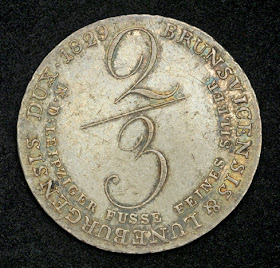 |
| German Coins 2/3 Thaler Silver Coin |
 |
| Coins of Germany |
German Coins, German coinage, German silver coins, Numismatic Collection, Coins of Germany best silver coins for investment, silver coins, old coins, coin collecting, rare coins, world coins, foreign coins, heritage coins, silver ira investment, silver bullion coins, silver coin collection investors, investment coins, antique coins, Unique Silver Coins, collectible coins.
Obverse: Wreathed bust of George IV as Duke of Hannover and King of Great Britain left. Engraver´s initial (C) below.
Legend: GEORG . IV D . G . BRIT . & . HANOV . REX F . D . BR . & . LUN . DUX .
Reverse: Large thaler value numeral (2/3) above two bands of legends.
Inner Legend: N. D. LEIPZIGER FUSSE FEINES SILBER .
Outer Legend: BRUNSVICENSIS & LUNEBURGENSIS DUX . 1829
Denomination: 2/3 Thaler
Reference: AKS 39, Jaeger 24a, KM-140. R!
Weight: 12.98 gram of Silver; Diameter: 33 mm
The House of Hanover (the Hanoverians) is a Germanic royal dynasty which has ruled the Duchy of Brunswick-Lüneburg (German: Braunschweig-Lüneburg), the Kingdom of Hanover and the Kingdom of Great Britain and the Kingdom of Ireland. It succeeded the House of Stuart as monarchs of Great Britain and Ireland in 1714 and held that office until the death of Victoria in 1901. They are sometimes referred to as the House of Brunswick and Lüneburg, Hanover line. The House of Hanover is a younger branch of the House of Welf, which in turn is the senior branch of the House of Este, with all three being offshoots of the ancient Saxon House of Wettin.
Queen Victoria was the granddaughter of George III, and was a descendant of most major European royal houses. She arranged marriages for her children and grandchildren across the continent, tying Europe together; this earned her the nickname "the grandmother of Europe." She was the last British monarch of the House of Hanover; her son King Edward VII belonged to the House of Saxe-Coburg and Gotha since she could not inherit the German kingdom and duchies under Salic law. Those possessions passed to the next eligible male heir, her uncle Ernest Augustus I of Hanover, the Duke of Cumberland and Teviotdale—the fifth son of George III. In the United Kingdom, after World War I, King George V changed the house's name from Saxe-Coburg and Gotha to the currently serving House of Windsor in 1917. Both dynastic names are offshoots of the 800-plus years old House of Wettin.